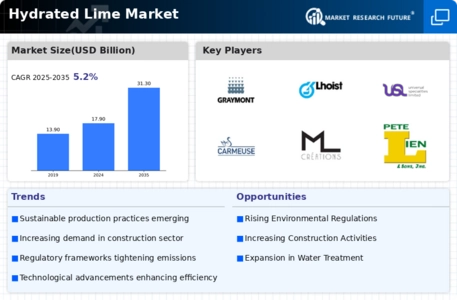Market Share
Hydrated Lime Market Share Analysis
Market share positioning strategies are pivotal for companies operating in the hydrated lime market, where competition is fierce and market dynamics are constantly evolving. Hydrated lime, also known as calcium hydroxide, is extensively used in various industries including construction, agriculture, water treatment, and chemical manufacturing. To effectively navigate this competitive landscape and capture a larger market share, companies employ a range of strategic approaches tailored to their strengths, market conditions, and customer preferences.
One prominent strategy employed by companies in the hydrated lime market is product differentiation. By offering unique features, formulations, or grades of hydrated lime, companies can cater to specific customer needs and preferences. For example, they may develop specialized hydrated lime products with enhanced purity levels, particle sizes, or reactivity rates to better meet the requirements of different applications. This differentiation allows companies to carve out a niche within the market and attract customers seeking tailored solutions, thereby increasing their market share.
Cost leadership is another prevalent strategy in the hydrated lime market, particularly in industries where pricing is a primary consideration for buyers. Companies that excel in cost leadership aim to become the lowest-cost producers within the industry by optimizing production processes, sourcing raw materials efficiently, and minimizing overhead expenses. By offering competitively priced hydrated lime products, these companies can appeal to price-sensitive customers and gain market share through increased sales volume. Cost leadership also enables companies to withstand pricing pressure from competitors and maintain profitability in a competitive market environment.
Market segmentation plays a crucial role in market share positioning for hydrated lime manufacturers. By dividing the market into distinct segments based on factors such as industry, application, or geographic location, companies can tailor their products and marketing strategies to better address the needs of specific customer groups. For instance, they may develop specialized hydrated lime formulations for use in environmental remediation, wastewater treatment, or soil stabilization, each with unique properties and performance characteristics. By focusing on targeted market segments, companies can more effectively position themselves and capture market share within specific niches.
Strategic partnerships and collaborations are also instrumental in market share positioning in the hydrated lime market. By forming alliances with suppliers, distributors, or end-users, companies can leverage synergies and resources to expand their market reach and penetration. Collaborative initiatives may include joint product development projects, co-marketing agreements, or strategic alliances with industry associations. By working together with partners, companies can access new markets, distribution channels, and customer segments more efficiently, thereby increasing their market share and competitiveness.
Investing in research and development (R&D) is essential for companies seeking to differentiate themselves and maintain a competitive edge in the hydrated lime market. By continuously innovating and improving their products, companies can develop new formulations, enhance product performance, and address emerging market trends and customer demands. This may involve exploring alternative production methods, optimizing product characteristics, or developing value-added applications for hydrated lime. By staying at the forefront of technological advancements and market developments, companies can strengthen their competitive position and capture a larger share of the market.
Branding and marketing strategies are also critical for market share positioning in the hydrated lime market. Building a strong brand identity and effective marketing campaigns can help companies differentiate themselves from competitors and create value perception among customers. This may involve highlighting the quality, reliability, and sustainability of their hydrated lime products through advertising, digital marketing, and participation in industry events. By establishing a compelling brand presence, companies can enhance customer loyalty and command premium prices for their products, thereby increasing their market share and profitability.
Lastly, ensuring regulatory compliance and maintaining product quality are essential for market share positioning in the hydrated lime market. Companies must adhere to relevant industry standards and regulations governing product quality, safety, and environmental impact. By demonstrating a commitment to compliance and sustainability, companies can build trust with customers and gain a competitive advantage over less reputable competitors. This involves implementing robust quality control measures, conducting regular audits, and obtaining necessary certifications to ensure product authenticity and safety.


 Source: Secondary Research, Primary Research, Market Research Future Database and Analyst Review
Source: Secondary Research, Primary Research, Market Research Future Database and Analyst Review








Leave a Comment